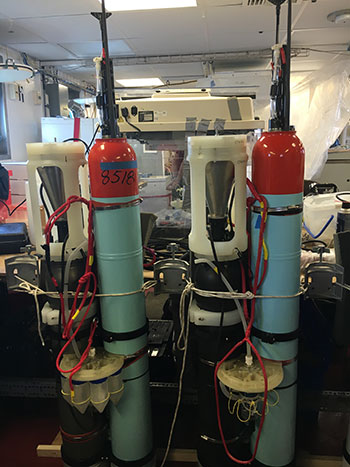The ocean’s biological carbon pump occurs at very fast time scales, so it has been difficult to study the various environmental dynamics influencing its processes. Determining whether the carbon pump is strengthening or weakening – and why – would require ongoing monitoring that is impractical to do for humans on a ship.
That is where robotic technology comes in. Berkeley biogeochemist Jim Bishop invented the optical sedimentation recorder (OSR), an instrument designed to catch organic matter sinking vertically and funnel it to a glass platform. A camera below the platform takes images at regular intervals, and those images can determine the nature of the matter that settles on the glass stage.
The OSRs typically hang down from surface buoys, but research has indicated that such tethering makes them susceptible to a sideways pull that affects the quantity of particles collected.
Working with Berkeley Lab engineers Todd Wood and Tim Loew, Bishop paired the OSR platform with Sounding Oceanographic Lagrangian Observers (SOLO) floats, a platform pioneered by the Scripps Institution of Oceanography to measure temperature and salinity. SOLO floats can repeatedly sink to a pre-programmed depth and remain there for days before surfacing again to send out its data and location information.
The paired systems gave birth to the Carbon Flux Explorer (CFE), designed to observe changes in ocean carbon sedimentation at regular intervals for days, weeks and months at a time.
A recent Biogeosciences study by Bishop and colleagues from tethered monitoring systems found that the strength of carbon export off the coast of California is likely underestimated by at least a factor of 3, and at times by a factor of 20.
This discrepancy suggested that free-floating carbon sedimentation monitoring systems are needed.
Of the four robots set for deployment this trip, two will have sample collection capabilities that will help the researchers calibrate the results with the optical data.
Below is a diagram of the Carbon Flux Explorer without the newly designed sample collection trays.
Argos Antenna – Sends satellite signals with data results
Iridium Antenna/GPS – Signals the robot’s location
Seabird CTD – Keeps birds away
Cleaning Pump – Periodically clears the special light sensor of debris
Baffle – Protects the robot from marine mammals
Funnel – Collects organic matter and directs it to the imaging stage
Down Light with Polarizer – Used to determine presence of calcium carbonate
Settling Column – Gives the collected stuff a chance to stop moving
Dark Field Light – Used to detect organic matter
Sample Stage – Gathers collected stuff for pictures
Polarizer Rotator – Turns polarizers so that they are 90 degree angles to each other
Imager – Takes pictures
CPU microcontroller – The brain of the robot
Tensioning rod for bottom cap – Squishes the robot together
Batteries – Robot’s power source
The development of the Carbon Flux Explorer is an ongoing process that doesn’t stop. With support from the Department of Energy’s Office of Science, the researchers began the development of the robotic float in 2000, and the first model made its inaugural splash in 2007. The National Science Foundation (NSF) picked up funding for the project in 2010. NSF is funding this research cruise to test the latest version of the Carbon Flux Explorer (CFE-Cal) with the sample collection system.
Below are links to previous stories about Bishop’s robotic floats:


